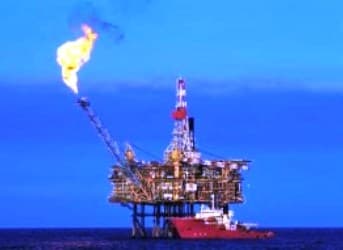A major new study finds that methane emissions from the production of shale gas may in fact be higher than previously thought. The study, published in the Proceedings of the National Academy of Sciences on November 25, casts into doubt the notion that natural gas produces half as much greenhouse gas pollution as coal. Natural gas has been embraced by many, including President Obama, as a centerpiece of America’s climate change plan.
Methane can be released from natural gas wells during the drilling process. Scientists have thus far had difficulty measuring these “fugitive methane emissions” precisely, with competing studies stirring controversy. The latest report, published by a group of 15 scientists, found that the U.S. Environmental Protection Agency is significantly underestimating the amount of methane released during natural gas production. Specifically, the report concludes that fugitive methane emissions could be 50% higher than EPA estimates.
The findings could put pressure on state environmental regulators as well as the U.S. EPA to draw up new regulations, according to Dan Lashof of the Natural Resources Defense Council. “Methane is a powerful climate change pollutant, and the study gives greater impetus to the EPA and states to establish stronger standards to reduce leaks from the oil and gas system,” he said in an interview. Similarly, Dan Grossman of the Environmental Defense Fund told NPR in an interview last week, “[w]e think that other states will look at what we were able to accomplish here and replicate it.”
Related article: Shell Produces Gas at Record Low Cost in China
If the latest figures are accurate, it could mean that the greenhouse gas advantage that natural gas has over coal could be a mirage. The Energy Information Administration estimates that U.S. carbon dioxide emissions declined 12% since 2007, citing natural gas supplanting coal as a major reason. That number does not account for methane emissions however.
Colorado is leading the charge in regulating methane, as its air quality regulators recently proposed rules that would require tougher standards at drilling sites. The rules would force operators to use infrared cameras to detect leaks; conduct inspections of pipelines, tanks, and other equipment on a monthly basis; and observe stricter limits when operating near residential communities. No other state has enacted rules that target methane pollution.
The regulations in Colorado enjoy the support of several key industry players, including Anadarko, Encana, and Noble Energy. They agreed to the regulations because of public pressure to do so. State elections in early November saw four Colorado communities ban hydraulic fracturing. Oil and gas companies hope that by cooperating with regulators, they can quell opposition to drilling. Still, they caution that compliance with the rules will cost up to $80 million a year due to required inspections. The Colorado Department of Public Health and Environment estimated the annual cost would only reach $30 million.
By. Nick Cunningham



















I'd love to see someone investigate the "true cost" incurred by the public, especially in health care costs associated with air and water pollution, local and state tax incentives for the O&G industry, costs to municipal water systems competing for the water used to produce O&G, as well as the effects on the flora and fauna from increased dust, destroyed habitat, and water use and pollution.
Anyone who is a systems thinker understands that any business that relies on the use of such vast tracks of land and water, on the surface and underneath the surface of the earth, is a highly suspect business. The costs, I'd bet, out way the benefits for the public.
The fact that the O&G industry has $80million to spend on assuring they are protecting the health and welfare of the communities they do business in, is again suspect.
Let's push progressing renewable resources, and the consumption of renewable energy to heat our homes, cook our food, and travel.
extraction business. Hubbert's curve and knowledgable analysts remind us
the downside of oil extraction is only 1 1/2 to 2 years away and the world will
be fundamentally different after as a result. Mary is correct in calling for transition
to renewables not just to reduce climate impact but to continue a semblance of
civilisation when this downhill snowball of oil depletion gets rolling